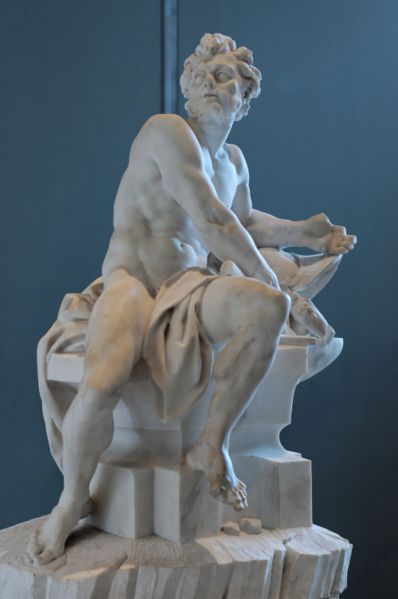[Home]
[The Olympians]
[Myths]
[Gallery]
HEPHAESTUS
"GOD OF THE FORGE"

Hephaestus was a Greek god whose Roman equivalent was Vulcan. He is the son of Zeus and Hera, the King and Queen of the Gods (or perhaps of Hera alone). He was the god of technology, blacksmiths, craftsmen, artisans, sculptors, metals, metallurgy, fire and volcanoes. Like other mythic smiths but unlike most other gods, Hephaestus was lame, which gave him a grotesque appearance in Greek eyes. He served as the blacksmith of the gods, and he was worshiped in the manufacturing and industrial centers of Greece, particularly in Athens. The center of his cult was in Lemnos. Hephaestus's symbols are a smith's hammer, an anvil and a pair of tongs, although sometimes he is portrayed holding an axe.
In one tradition clearly attested in Homer's Odyssey and perhaps also in the Iliad, Hephaestus was born of the union of Zeus and Hera.In another tradition, which was only unambiguously recorded in late texts, but which may be an archaic survival of an autonomous Hera, she bore Hephaestus parthenogenetically; she is given the motivation in Hesiod's Zeus-centered cosmology that she was engaged in a competitive quarrel with Zeus for his "birthing" of Athena, but Attic vase-painters illustrated the mainstream tradition that Hephaestus was already present at the birth of Athena, seen to be wielding the hammer with which he had split Zeus' head to free her.
Because he was lame, Hera threw him out of heaven in disgust; alternatively, he was rendered lame by the fall. Or, he was flung by Zeus, because he came to his mother�s rescue when Zeus had her in fetters for opposing him. He fell into the sea, where Thetis and the Oceanid Eurynome cared for him in a sea cave. Or he fell for an entire day and landed on the island of Lemnos, where he was cared for by the Sintians, an ancient Lemnian tribe. In every case, he remained forever lame.
In an archaic story, Hephaestus gained revenge against Hera for rejecting him by making her a magical golden throne, which, when she sat on it, did not allow her to leave it. The other gods begged Hephaestus to return to Olympus to let her go, but he refused, saying "I have no mother".
At last Dionysus, sent to fetch him, shared his wine, intoxicating the smith, and took him back to Olympus on the back of a mule accompanied by revelers, a scene that sometimes appears on painted pottery of Attica and in Corinth, as well. In the painted scenes the padded dancers and phallic figures of the Dionysan throng leading the mule show that the procession was a part of the dithyrambic celebrations that were the forerunners, in Athens, of the satyr plays of the fifth century.
The theme of the return of Hephaestus, popular among the Attic vase-painters whose wares were favored among the Etruscans, may have carried this theme to Etruria.[24] As vase-painters portrayed the procession, Hephaestus was mounted on a mule or a horse, accompanied by Dionysus, who held the bridle and carried Hephaestus' tools, which include a double-headed axe.
The traveller Pausanias reported seeing a painting in the temple of Dionysus in Athens, which had been built in the 5th century but may have been decorated at any time before the 2nd century CE, when Pausanias saw it:
"There are paintings here � Dionysus bringing Hephaestus up to heaven. One of the Greek legends is that Hephaestus, when he was born, was thrown down by Hera. In revenge he sent as a gift a golden chair with invisible fetters. When Hera sat down she was held fast, and Hephaestus refused to listen to any other of the gods save Dionysus � in him he reposed the fullest trust � and after making him drunk Dionysus brought him to heaven."
